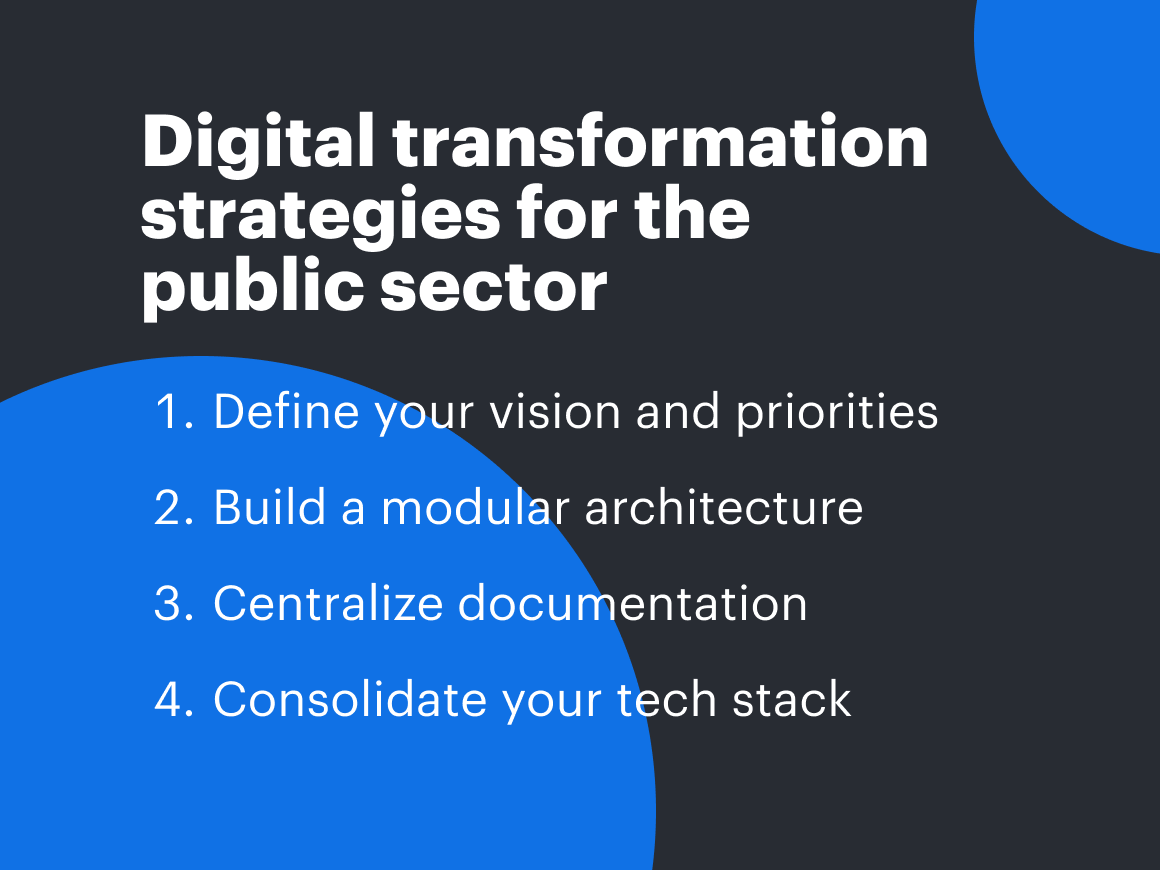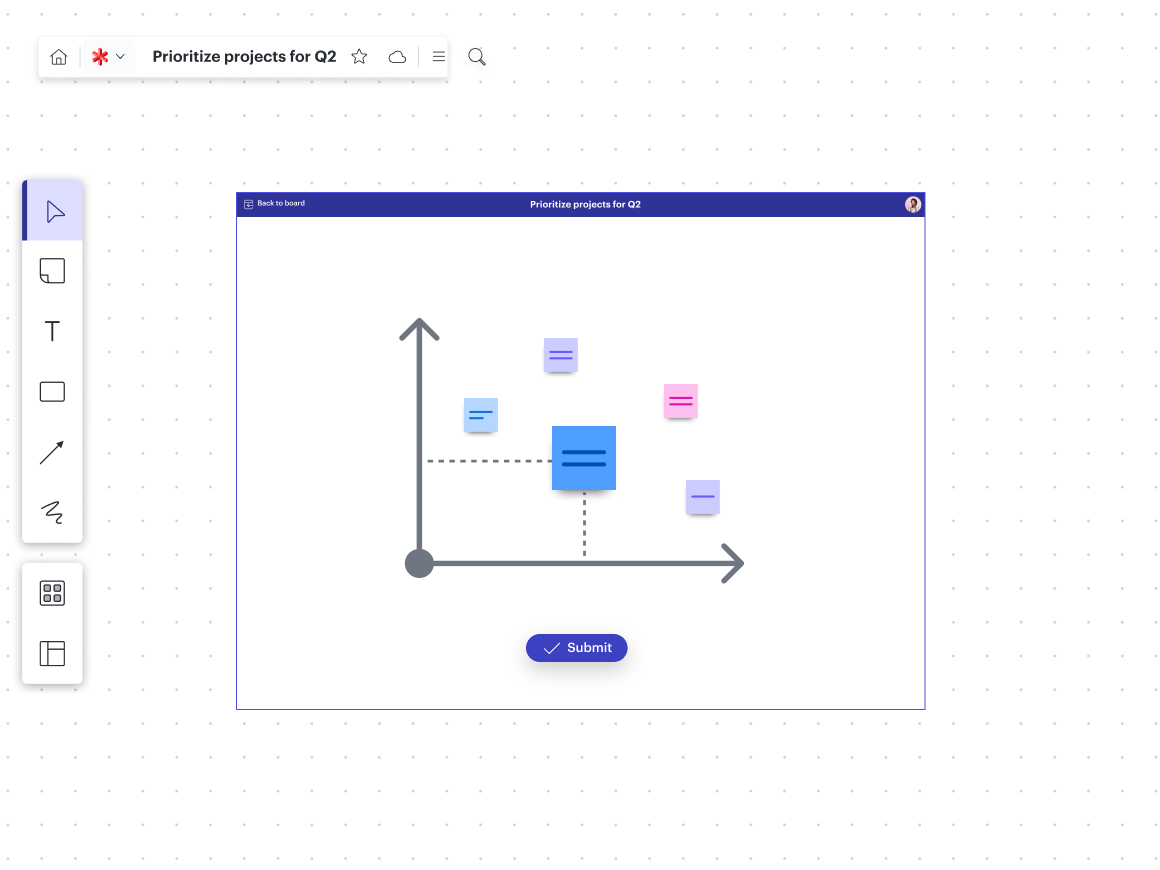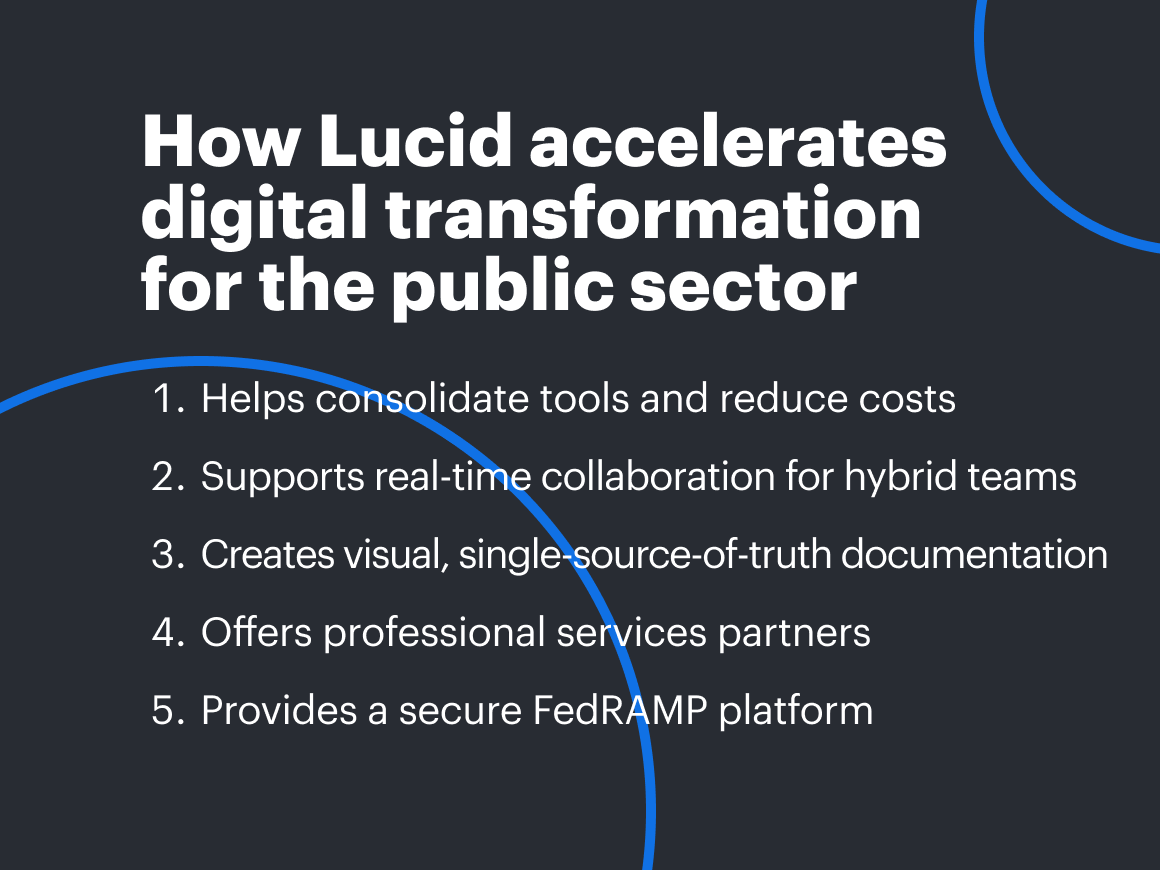
Public sector digital transformation: 4 strategies for increasing clarity, alignment, and adaptability
Reading time: about 11 min
Key takeaways
-
Digital transformation is essential for the public sector, but many transformation strategies fall short due to funding, risk aversion, and organizational silos.
-
A visual collaboration solution like Lucid helps organizations manage complexity and modernize to accelerate digital transformation.
-
It’s important for organizations to define their vision, build a central architecture, centralize documentation, and consolidate their tech stack.
The public sector is facing more pressure than ever to digitize their organizations—and the bar is set high.
Citizens expect their government services, like renewing a passport or filing taxes, to deliver the same seamless, user-friendly experiences as banking or shopping online. And public sector employees’ expectations for their work experiences, like productive meetings and clear communication, are just as high.
The COVID-19 pandemic underscored the need for government digital transformation strategies, and 80% of public sector leaders agree that the next five years will bring even greater disruption. These years of turbulence reveal that digitization is not only necessary for innovation and modernization, but it’s also a critical component of operational resilience.
Despite the obvious benefits available, digital transformation in the government is no easy feat. But it is possible. For public sector digital transformation to succeed, leaders need an approach that prioritizes clarity, alignment, and adaptability.
Why public sector digital transformations fall short
It’s no secret that the public sector is up against a lot of challenges when it comes to implementing digital solutions. From strict budgetary cycles to long procurement processes, politicized decision-making, and strict security and compliance requirements, there’s a lot working against them.
Perhaps the biggest reason government digital transformation strategies fall short, though, is that they’re complex. And when initiatives are complex, it’s difficult to make decisions, manage budgets, and enact change to move forward.
In the public sector, digital transformation complexity stems from a few main factors:
- New territory introduces many unknowns: For starters, there are so many digital opportunities to pursue, from digitizing documentation to implementing new technology like generative AI. It’s difficult to prioritize efforts and determine their impact—or even more intimidating, their risk. And when an initiative is decided upon, it’s often unclear who will lead the effort and how they’ll do it.
- Attracting and maintaining talent: According to Gartner®, internal skills is the top challenge to modernization in government, above regulatory/vendor data compliance. (Gartner, “Government Strategies for Enterprise Applications Modernization Success,” February 28, 2025). Skilled professionals are essential for executing modernization strategies.
- Siloed agencies and departments: Without a proper way to collaborate across silos, determining implementation and funding strategies for digital transformation efforts is a convoluted process.
- Hierarchical structures: To further add to the complexity, government projects typically involve many major stakeholders, both internal and external, which can drastically slow down decision-making and even halt progress altogether.
Public sector organizations that address complexity, the root cause of their digitization challenges, will be better suited to improve employee and citizen experience, boost efficiency, and increase resiliency.
How the public sector can manage complexity and accelerate digital transformation
When dealing with complexity, the goal isn’t necessarily to create order or simplicity. The goal is to understand the complexity, and over time, as you learn more about the situation, solutions will emerge.
For that reason, a successful government digital transformation strategy hinges on the public sector’s ability to create clarity wherever possible. Organizations should align teams around change and adapt strategies regularly.
The following strategies can help the public sector achieve the level of clarity, alignment, and adaptability it needs to manage complexity and digitally transform its organizations.

Define your vision, priorities, and strategy
According to Deloitte, one of the greatest challenges governments face in digital transformation, regardless of digital maturity, is siloed transformation priorities. With so many stakeholders involved, reaching an agreement on what the top priorities are—and how you’ll achieve them—can be a long and arduous process.
By nature, this type of decision-making is highly collaborative. It requires ongoing communication, information sharing, and feedback. And when decisions are made, keeping teams aligned on their role in the process is an ongoing challenge.
To accelerate decision-making and align teams around priorities, public sector organizations can try these strategies:
Leverage solutions to capture feedback. To ensure the right voices have a chance to weigh in, you can’t rely purely on written communication like email (where important messages get buried and miscommunications slow progress) or synchronous meetings (where those who can’t attend live are left out). Instead, use solutions that allow contributors across teams or agencies to share ideas, questions, and concerns in real time or asynchronously.
For example, with Lucid, public sector teams can use Visual Activities to collectively determine priorities, assessing factors like risk, impact, and business value. Teams can simply share an interactive, cloud-based activity with stakeholders, then automatically aggregate results after everyone’s weighed in to see areas of agreement or dissent. Visual Activities can be used during a meeting, asynchronously, or with a mix of both to help make group decisions quickly.

Bake adaptability into your plan. Using the priorities you’ve defined, build a roadmap that clarifies key milestones, dependencies, and roles—but leave room for iteration. Experimentation is key to digital transformation for the public sector, so treat your roadmap as a living document and adjust your plans as you uncover new insights. Use success metrics, like OKRs, to determine if you’re meeting your digitization goals or if it’s time to change course.
Identify quick wins. If you’re just beginning your digital transformation, start with near-term, quick wins. Smaller digitization efforts can help you get better data to drive future decisions, show value, and build a foundation for larger-scale digital initiatives later on. Plus, by sharing wins, you’ll help the entire organization see the potential of digital transformation.

Build a flexible, modular solution and data architecture
A flexible architecture is one of the most foundational elements needed to support digital transformation. Public sector organizations should adopt service-oriented architecture that enables fast experimentation, democratizes application building, and connects silos.
But designing flexible, modular architecture requires full visibility into what data you already have, as well as a way to visualize your future state. Here’s where to start:
Use intelligent tools to visualize your data and architecture. Visualization is key to gaining clarity into your systems, their relationships, and the impact of changes. You’ll want to start by using architecture templates to visualize the current state of your solution and systems architecture down to your APIs and data architecture. Then, you can work with stakeholders to brainstorm what a future state would look like and map that out. Use these visuals to get organizational buy-in.
Work backwards by first understanding your citizen experience. For example, if your goal is to develop an online payment processing system, begin by mapping out the ideal citizen experience for making payments online. Then, use an experience map as a guide to determine how you need to structure, segment, and connect your data and systems to make that experience possible.
Improve your architecture incrementally. For many public sector organizations, a modular data architecture and strong API strategy may represent a dramatic shift from their current systems setup. Keep in mind that you don’t need to rearchitect the whole system at once. Instead, build flexibility into your architecture over time, starting with systems you need to adjust to support your roadmap.
Lucid case study: Visualizing complex architectures
A large public health agency’s modernization goals were delayed because they lacked the proper visibility into their architecture. They tried using SharePoint and Visio for diagramming, but the limited collaborative functionality made it difficult to share the diagrams and align stakeholders on the architectures' current state.
By transitioning to Lucid, the agency could collaborate in real time, eliminating versioning issues and centralizing documentation. Lucid helped them gain visibility into their entire architecture, which allowed the DevOps teams to make confident decisions quickly.

Centralize and streamline documentation
Documentation is one of the most important elements to align cross-functional teams and identify new opportunities for automation, improvement, or digitization. To support their government digital transformation strategy, public sector teams need to document everything from internal processes and organizational structure to implementation plans and supporting systems.
Without an easy way to create, maintain, and house all this documentation, it’s easy to see how versioning issues, misunderstandings, and difficulty finding information could slow down important projects.
That’s why for digital transformation in the government to succeed, agencies must prioritize ways to streamline their documentation process. Here’s how:
Create documentation as you work. Instead of treating documentation like a separate process, look for ways to create documentation naturally as you work. For example, if you use a virtual whiteboard to collaborate, you can naturally create a record of your ideas, decisions, plans, and more in one place.
Use cloud-based platforms to house documentation. A cloud-based platform ensures that teams can access the documents they need anytime, anywhere. To reduce the risk of important information leaving the organization when employees leave, look for platforms with advanced admin controls like document retention, domain control, and user permissions.
Modernize and consolidate your tech stack
IT modernization is a key public sector business transformation strategy.
According to the 2023 Gartner Legacy Modernization Survey, “more than half (57%) of governments are running 60% to 80% of their workloads in core systems (that is, systems of record providing core capabilities). Thirty percent of these systems are more than 10 years old, creating significant challenges to modernization, such as the availability of necessary expertise, antiquated architectural models, nonstandard data models and aged documentation.” (Gartner, “Government Strategies for Enterprise Applications Modernization Success,” February 28, 2025).
In order to modernize your tech stack, understand architecture requirements, and centralize documentation, you need the right tools.
Visual collaboration has emerged as the most powerful solution to support data-driven collaboration and alignment for teams. And the best part is that a comprehensive visual collaboration platform, like Lucid, can replace multiple point solutions and help the public sector do more with less.
But not all collaboration platforms are created equal. For public sector orgs to truly simplify their tech stacks, it’s important to look for a solution that:
- Supports different teams’ use cases. Prioritize a platform that can support flexible, real-time brainstorming to advanced, technical diagramming.
- Leverages automation and data to increase efficiency. Look for solutions that use automation for key use cases (such as creating cloud infrastructure diagrams) to help you gain clarity and alignment quickly.
- Is easy to implement and learn. It’s important that each new solution the public sector adopts is user-friendly and easy to start using. And if you’re transitioning from legacy diagramming solutions like Visio, look for solutions that offer tools or services to migrate your work over.
- Advanced security and governance controls. Not all collaboration platforms have the security controls the public sector needs to safeguard their data. Look for solutions that prioritize security so your teams can collaborate with confidence.

Buyer’s guide
Learn how to choose the right collaboration platform for your collaboration, diagramming, and security requirements.
Get the guideHow Lucid accelerates digital transformation for the public sector
With the power of Lucid, many public sector organizations have successfully digitized their core processes, increased innovation, and improved alignment for their hybrid workforce. In fact, 88% of our customers say Lucid enables them to be more productive, and 83% say Lucid increases alignment among their hybrid teams.

Here’s how Lucid powers digital transformation for the public sector:
- One platform for all collaboration needs: By combining intelligent diagramming, virtual whiteboarding, and cloud visualization in one platform, Lucid helps public sector organizations consolidate their tech stack. And with Lucid’s universal canvas, it’s easy for teams and stakeholders to collaborate seamlessly across the entire project lifecycle.
- Collaboration from anywhere, anytime: Lucid is cloud-based, meaning that collaborators can brainstorm, plan, give feedback, and work together—regardless of location, time, or device.
- Visual single-source-of-truth documentation: In Lucid, teams can centralize documentation around processes, architectures, plans, and anything else to increase alignment, thanks to the Agility Accelerator, Cloud Accelerator, and Process Accelerator add-ons.
- Professional services: With an experienced team of professional services experts, Lucid can provide strategic guidance for each organization’s unique digital transformation needs. From document migration services (from platforms such as Visio) to tailored onboarding, we partner with you every step of the way.
- Secure and compliant: Lucid is FedRAMP Authorized at the Moderate impact level, so public sector organizations can trust Lucid to power their mission-critical objectives while meeting compliance requirements. Lucid is built on AWS GovCloud infrastructure and is used by U.S. DoD agencies and contractors for defense, ITAR, and other controlled information.

Lucid for the public sector
Ready to see how Lucid can accelerate your digital transformation?
Get in touchGARTNER is a registered trademark and service mark of Gartner, Inc. and/or its affiliates in the U.S. and internationally and is used herein with permission. All rights reserved.
About Lucid
Lucid Software is the leader in visual collaboration and work acceleration, helping teams see and build the future by turning ideas into reality. Its products include the Lucid Visual Collaboration Suite (Lucidchart and Lucidspark) and airfocus. The Lucid Visual Collaboration Suite, combined with powerful accelerators for business agility, cloud, and process transformation, empowers organizations to streamline work, foster alignment, and drive business transformation at scale. airfocus, an AI-powered product management and roadmapping platform, extends these capabilities by helping teams prioritize work, define product strategy, and align execution with business goals. The most used work acceleration platform by the Fortune 500, Lucid's solutions are trusted by more than 100 million users across enterprises worldwide, including Google, GE, and NBC Universal. Lucid partners with leaders such as Google, Atlassian, and Microsoft, and has received numerous awards for its products, growth, and workplace culture.
Related articles
Improving operational efficiency in the public sector with Lucid
Efficiency requires modern collaboration. Learn how to streamline processes, align on decisions, and save hours on documentation.
The public sector's toolkit for effortless documentation
A modern documentation process is the key to accelerating innovation for public sector teams. Learn more here.
5 organizational change management strategies for a modern workforce
Organizational change management is complex. Learn from Lucid’s experts on how to pull off a company-wide shift.
How 5 public sector orgs are accelerating modernization and boosting efficiency with Lucid
Read how five public sector agencies and contractors have increased efficiency, accelerated IT modernization, and reduced costs with Lucid.
